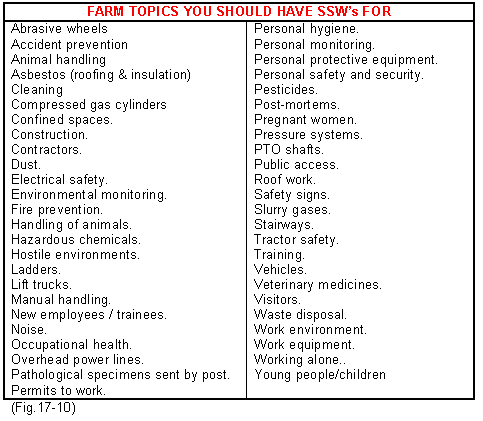



Document your Safe Systems of Work
All of the components of your risk assessments and management procedures can now be combined into a series of working documents - the Safe Systems of Work
(SSW's).
The assessment process should have identified the things that need to be done. The management procedures should ensure that they are done. This combined health and safety working system is therefore designed to ensure your due diligence. In the event of an accident, if you cannot prove due diligence you will have little or no defence against legal action or civil claims. The key points that should be incorporated into the SSW's are as follows:
The regulations
Each SSW should include a note of the Specific Regulations, ACOPs
Industry Standards, etc. that apply to the particular aspect of health and
safety covered (e.g. noise) and a brief description of what you are obliged to
do to comply.
Policy statement
Your policy on the particular aspect of health and safety should be
stated, along with who is responsible for ensuring that the policy is
implemented.
Risk assessment
The significant findings of the risk assessments with regard to the
specific topic should be noted and attention should be drawn to the detailed
assessment records that are on file and who is required to read them. This will
only apply to those employees who work in areas or carry out procedures that
were assessed as presenting risks. The assessment records will mention any
specific controls but the SSW should specify whether any general control
measures are required (such as the provision of safety notices), when they will
be implemented (priority rating) and what interim measures must be adopted. It
should also specify any control measures already in place that must be complied
with.
Instructions
The work instructions for specific procedures are not usually included
on the same page but are referred to elsewhere - such as a in separate file of
work instructions, on the assessment records or as laminated sheets that are on
permanent display at the points of use. The work instructions specify the
actual steps to take to perform a task safely. General safety points are
usually included on the SSW and specify the codes of practice that all
employees must adhere to in order to ensure that risks remain adequately
controlled.
Records
The SSW should specify what records are to be kept e.g. personal
monitoring records, work equipment inventories and inspection records, staff
training in the correct use of PPE etc. and who should keep them, how, when and
where.
Hazard and safety data information
Together with the information regarding legal obligations,
responsibilities and employee duties, the nature of the hazard e.g. noise and
how it can cause harm damage hearing, affect concentration, should also be
described on the SSW. It should also contain references to any other
information or safety data that is relevant or which may be needed for
assessment purposes e.g. machinery and equipment literature that gives details
of noise levels under different conditions.
The overall aim of this type of management system is to have a series of single documents, each one of which provides all of the key information about one aspect of health and safety. Everyone must be familiar with all of the SSW's.
Each SSW should clearly state where individual employees can find other information of relevance to them, for example specific work instructions, risk assessment records and safety data. In this way employees only have to read what directly applies to themselves.
Each SSW should also state when, how and by whom the necessary on-going safety checks, reassessments and audits will be carried out and the information updated and reviewed. These details should also be noted in a diary or on a year planner so that the people responsible can be reminded.
This type of system ensures that all aspects of health and safety have been appropriately addressed and enables you to demonstrate that they have been. It also makes safety inspections and audits very simple for you, external safety consultants and inspectors.
The UK example SSW for noise Fig.17-9 shows the type of information to be included. It is in a format that can be used for most health and safety topics and easily adapted to suit large or small organisations.

You should have SSW's for all aspects of health and safety that directly impact on you.
A list of farm topics for which you should have SSW's is given in Fig.17-10. This list is not exhaustive and you will need to compile your own.








